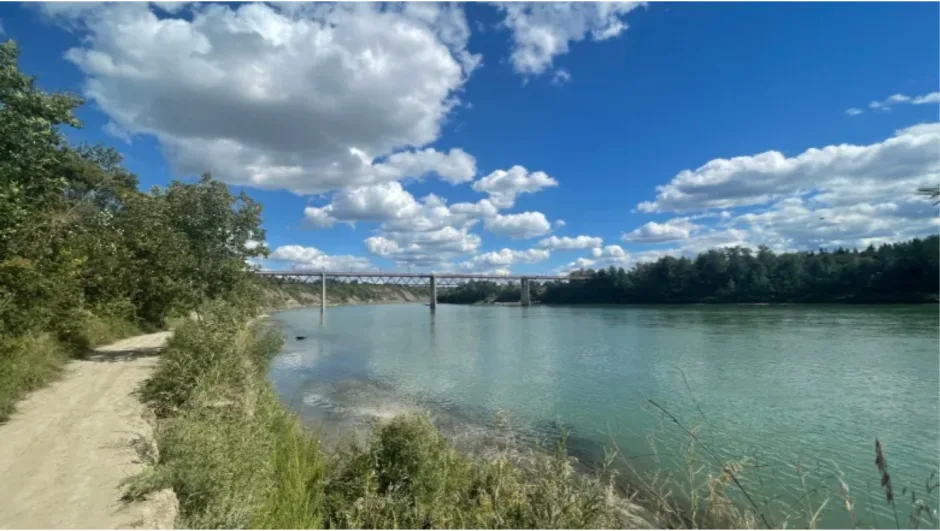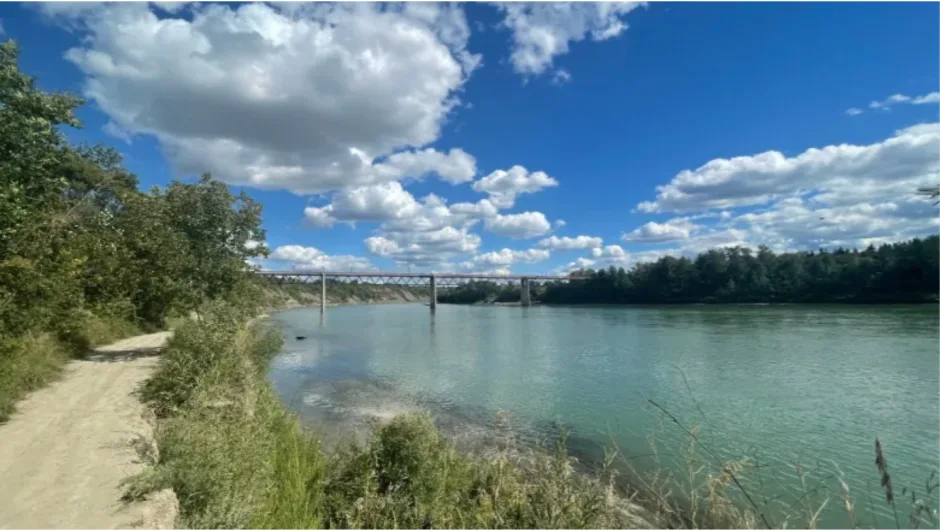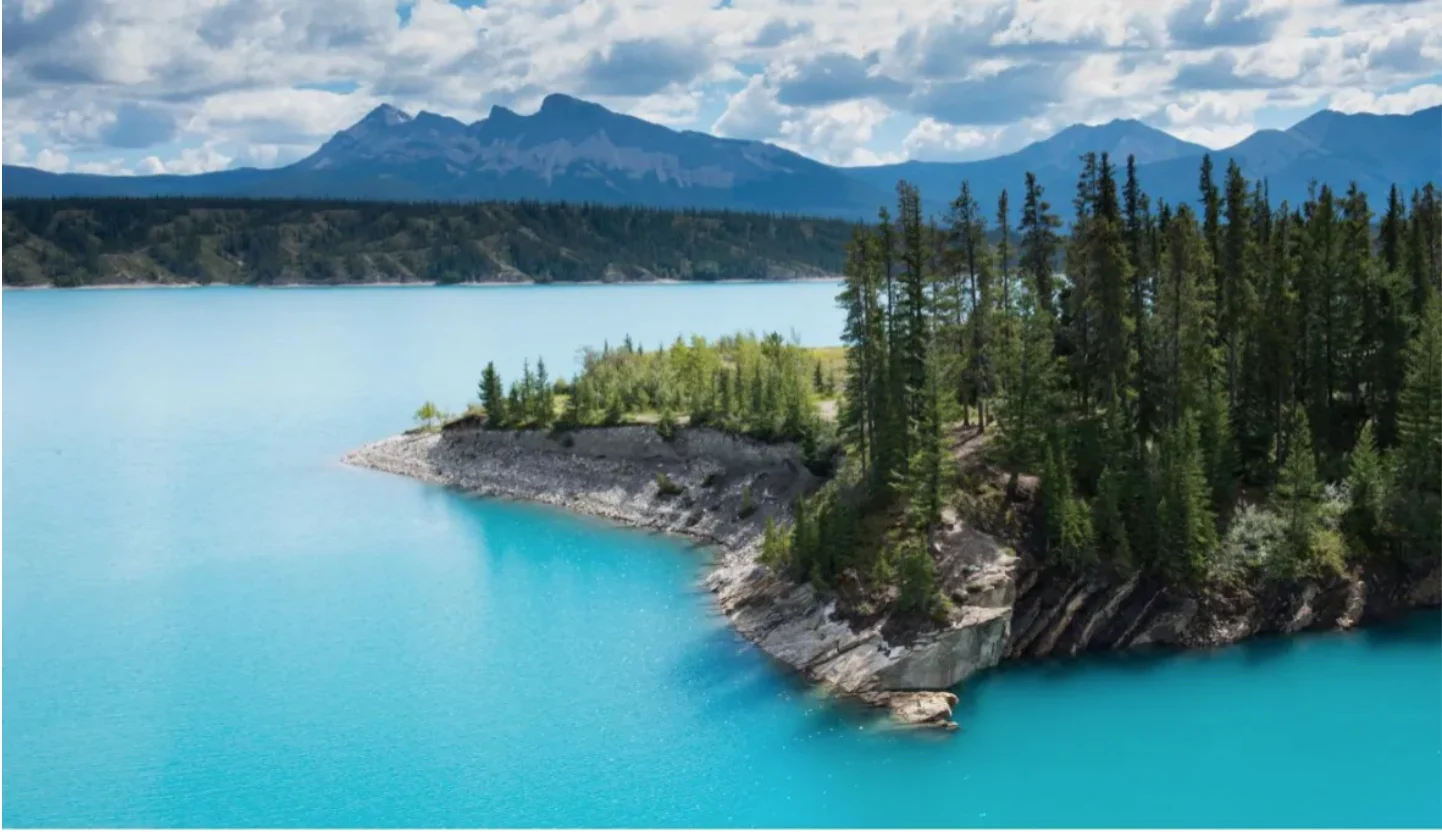
Why the North Saskatchewan River has gone from brown to blue

The North Saskatchewan has been a river of a different colour in Edmonton this summer. (Wallis Snowdon/CBC News)
The North Saskatchewan River looks less like chocolate milk than usual.
The clear, aquamarine waters have revealed hidden sandbars, darting fish, submerged shopping carts — and a flood of questions from Edmontonians seeking clarity on the colour change.
The river, which starts at the Saskatchewan Glacier in the Columbia Icefields in Alberta and flows through to central Saskatchewan, is usually a murky brown by the time it reaches Edmonton in summer.
In recent weeks, however, the water has taken on the hues of Alberta's glacial lakes, thanks to dry, hot weather combined with maintenance at a major dam.
"It's unusual," said Mark Loewen, a University of Alberta professor of water resources engineering. "Of all the years I've lived in Edmonton and been paying attention to the river, which is quite a few now, this is the clearest [it's been]."
WATCH BELOW: DOZENS OF NEW VIRUSES FOUND IN ANCIENT GLACIAL ICE
SETTLED SEDIMENT
The drought conditions along the river basin have reduced the amount of water flowing through the river, meaning sediment isn't being stirred up, Loewen said.
Provincial data shows the highest flow rate recorded this year was 350 cubic metres of water per second — a huge drop from normal.
The river's average flow usually peaks at 1,200 cubic metres per second, Loewen said. Last year, it hit 1,900 during heavy rains in July.
"That's when you see the really muddy-looking, sediment-laden water in the river," Loewen said. "If you don't have any higher flows like that, the water will be clearer."

Work to control the levels at Abraham Lake, known for its bright blue waters, also gave the river a colour boost, Epcor says. (Stephen Legault/via CBC)
Maintenance work done in July at the Bighorn Dam, about 330 kilometres southwest of Edmonton, involving a release of water from the Abraham Lake reservoir also contributed to the new hue, says Epcor, a utility company that manages water, wastewater and electricity distribution systems in Edmonton.
The river flows through the Rocky Mountains, pools in the reservoir with its clear blue waters, then snakes its way across the province.
The summer release means the river took in more water than usual from the dam, which has "substantially less organic matter" than the river's other headwaters, Epcor told CBC News.
ALGAE CARPETS BLOOM
This year's parched river basin and lack of sediment has created perfect growing conditions for algae, says Rolfe Vinebrooke, a University of Alberta biology professor.
Some smaller tributaries that feed into the river and fill it with organic matter have dried up, said Vinebrooke, who researches the river's vast network of tributaries.
The lack of sediment allows more light to penetrate the water's surface, contributing to algae growth. Some of the algae is microscopic and suspended in the water, while some has taken root as an underwater forest, he said.
"You'll start getting green algae carpets growing on the rocks and the bottom of the river, particularly when it's very shallow," he said.

The Saskatchewan Glacier, part of the Columbia Icefields in Banff National Park, is the headwaters of the North Saskatchewan River. (Submitted by Kyle Schole/CBC)
Vinebrooke said the river likely got its first colour boost this spring when baking temperatures arrived in the Rockies.
"When the [glaciers] really start melting rapidly like they did this year, they will contribute some of that whitish, silty material that some people refer to as rock flour. That can give the river kind of a turquoise-ish, bluish sort of colour."
A COLOUR-BLIND AFFECTION
Loewen said the North Saskatchewan is likely to return to its regular brown next summer, but he noted that its silty colour unfairly gives it a bad rap as a "dirty" river.
He's glad Edmontonians are giving the water more attention and appreciation, no matter what the colour.
"A lot more people realize, it's actually pretty cool — the river valley — and that you can actually do things in the river," he said.
"You don't have to just sort of stand on the bank and go, 'Yuck, that's terrible-looking.' And in fact, the quality of the water in the river is quite, quite nice."
This article, written by Wallis Snowdon, was originally published for CBC News.





